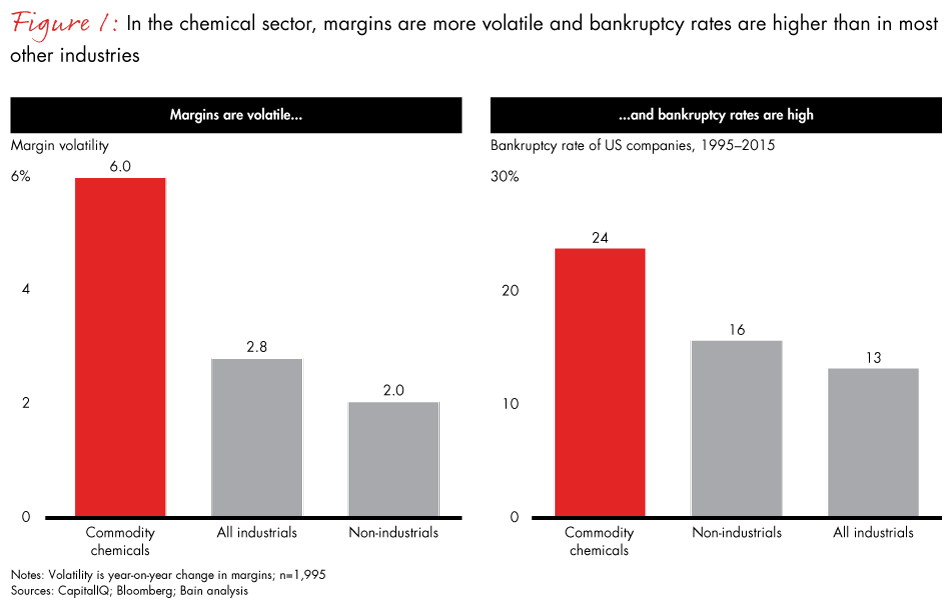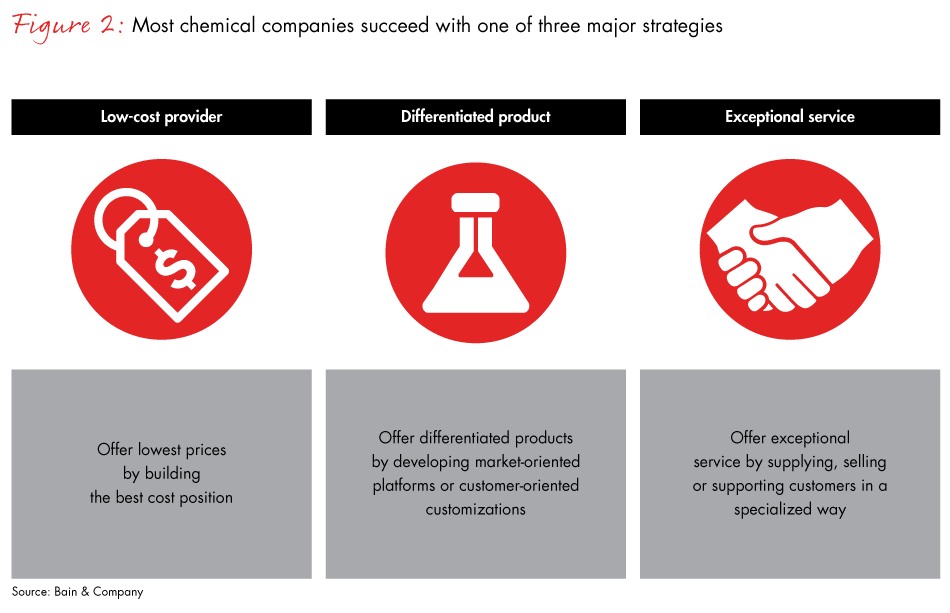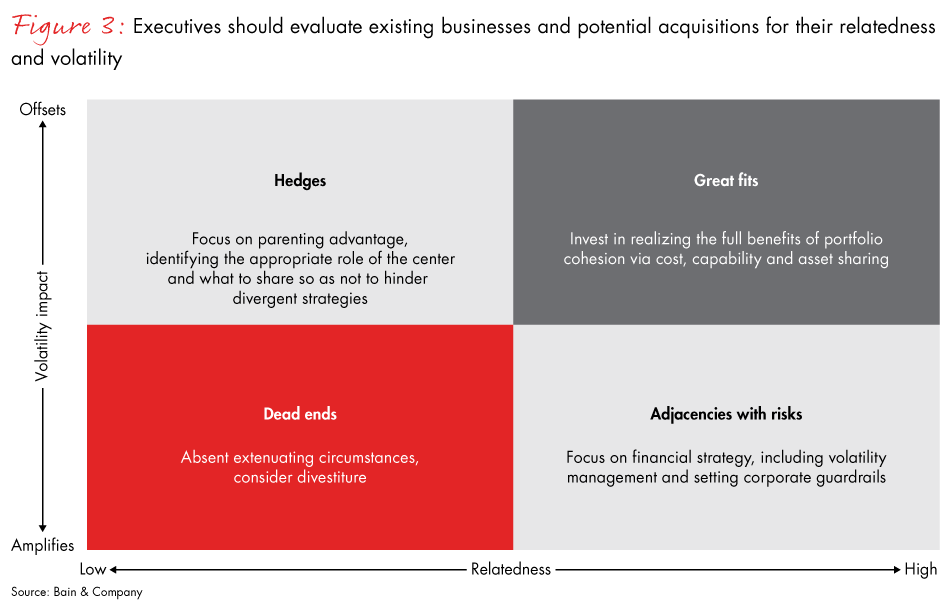Brief

Large chemical companies are often the result of a series of mergers and acquisitions that occur over time. Each deal may have made sense when it was completed. But since the sector changes rapidly, the resulting collection might not form an ideal suite of businesses.
To manage these assembled businesses, leading companies regularly assess their portfolio coherence—defined as the level of sharing between business units—and the magnitude of volatility they introduce. Active portfolio management is even more critical in chemicals than other sectors. The reasons—all too familiar to executives—are unique to the industry. Large changes in feedstock prices can alter the competitive position of plants. Profit pools shift up and down the value chain over time, changing the landscape of winners and losers. High capital requirements create long-term financial and strategic commitments. All these dynamics create higher levels of margin volatility, bankruptcy and financial stress in chemicals than in other industries (see Figure 1). To navigate successfully, executives review their portfolios, assessing these risks and managing their exposure to them.
Leading chemical companies are also sharply focused when setting their strategic goals and defining sources of advantage, and they use periodic reviews to validate each business unit’s alignment (or lack of alignment) with these goals. Bain research suggests this diligence pays off financially: Greater portfolio coherence at top chemical companies leads to lower margin volatility, stronger alignment of their businesses to a strategy and more effective sharing between businesses—all of which contribute to higher financial returns. For example, we found that commodity chemical companies that balanced volatility with coherence were able to grow earnings at twice the rate of the rest of the industry. Companies in this group delivered 2.5 to 4.5 times the total shareholder returns while seeing 30% lower margin volatility.

Align businesses around a common strategy
The first step in assessing the coherence of business units is to understand the broader organization’s central strategy. Chemical companies typically follow one of three well-known paths to success: low cost, differentiated products or exceptional service (see Figure 2). However, when a portfolio pulls in multiple directions, it can be challenging to meet the requirements of conflicting strategies. By designing their businesses around a common strategy, high performers send a strong message to investors, partners and employees about how they intend to compete in their markets. A common strategy across businesses also allows executives to develop a focused set of capabilities to enable success. They can build their operating model and cost structure around one strategy and share those skills to create value throughout the organization.

Alternatively, companies made up of businesses with divergent strategic approaches—for example, a low-cost producer in one segment combined with another business unit that invests heavily in innovation and R&D—may struggle to develop the capabilities necessary to thrive with multiple strategies. It will be harder to take the strengths that worked in one business and extend them to help their other businesses succeed. Worse, they may spread their focus too thin—so they find themselves performing adequately at many activities, but great at none.
As executives rationalize their portfolio, they should develop an understanding of the capabilities necessary to win in each business. In some cases, they may need to divest business units with outlying strategies that detract from success. Where divestitures are not realistic, companies may need to manage multiple strategies simultaneously, which can pose significant challenges to their operating model and cost structure.
Determine what gets shared
When determining which capabilities and resources to share among business units, chemicals executives know that not all sharing is equally valuable. It is most important to share the things that make you uniquely successful. Sharing the sources of advantage across business units—whether they are costs, capabilities or other resources—allows companies to extend their lead.
For example, in businesses pursuing a low-cost strategy, it is more valuable to share costs or common feedstock than to share customers. Westlake Chemical, for example, taps scale benefits through shared raw materials and highly integrated operations across its business units to achieve a low-cost position in multiple segments. The polyethylene and PVC businesses have common feedstocks, and the PVC business is highly integrated vertically. As a result, the company is able to extend its low-cost business structure into its acquisitions, keeping a sharp focus on costs as the top priority.
On the other hand, businesses pursuing innovation strategies to earn high value for their products will get far more out of sharing R&D capabilities, technology and go-to-market strategies than from sharing costs. One of the rationales for the Dow-DuPont merger is to realize benefits from shared customers to enhance relationships with decision makers and gain a deeper understanding of customer requirements. The improved R&D breadth also encourages the development of unique products to meet these customer needs.
Of course, it’s always possible to turn a virtue into a sin. Sharing makes sense when it helps achieve strategic goals. But companies that aggressively share costs, capabilities or resources across businesses with different support needs can sometimes create burdensome and unnecessary bureaucracy. Having identified the common sources of value, organizations should remain selective about sharing those features that make the company better, not just bigger.
Acquiring chemical companies requires strategic planning when it comes to organizing the portfolio. Mark Porter, who leads Bain’s Global Chemicals practice, shares two factors that influence the way portfolios are often organized and how they can influence the success of the acquisition.
Manage volatility
A key complication is that common strategies and the pursuit of overlap and synergies can expose businesses to greater volatility. Two business units that rely on similar raw materials can share costs to create better economy on inputs, but both are exposed to the same cycles and volatility in that material market.
A well-balanced portfolio reduces volatility for the company as a whole. Businesses that decrease volatility may be valuable to retain, even if their strategic approach is different. Businesses that amplify risk must create enough value to justify their inclusion. Depending on the deal, acquisitions can introduce organizational complexity at one extreme or financial volatility at the other. Wise executives keep an eye on both risks (see Figure 3).

For businesses that are not closely related to the core strategy but that reduce volatility (upper left), executives manage organizational complexity risks by deciding which capabilities should reside at the corporate versus business unit level and which practices should be standardized across businesses.
For businesses that are highly related to the core strategy but increase volatility (lower right), executives turn their focus to managing volatility.
- They can mitigate risk through actions within business units: building flexibility into supply contracts, diversifying geographic footprints or accessing different end markets.
- They can also address volatility through portfolio actions: expanding into a variety of derivatives from a common intermediate product, vertically integrating to capture profit pools as they move across the value chain or divesting businesses that create disproportionate risk.
- Finally, they can manage volatility through financial strategy: conserving cash in a “rainy day fund” for down markets, smartly managing debt covenants or share buybacks, or spreading capital expenditures across multiple periods.
Through regular, ongoing assessments of their portfolios, executives in the chemical sector can reduce their organization’s exposure to volatility while discovering opportunities to create synergies across business units. These assessments shed light on where to invest or divest, and can help executives shape a comprehensive acquisition strategy. Beyond M&A, insights from these assessments can also help executive teams determine the proper structure and interaction between the corporate center and business units, and thereby capture the benefits of the range of businesses.
One way to get started is by asking a few questions that can help shape portfolio analysis:
- How do each of our businesses generate value? Are their means of generating value similar or quite different?
- Which business units are most coherent in terms of their alignment with our strategy and the amount of volatility they introduce? Which do not fit as well?
- Where are the greatest opportunities to share capabilities and skills across our business units to extend our advantages?
- Are we creating financial risk through volatility? Are there any mitigating actions we could pursue?
The answers to these questions can establish the starting point for an in-depth assessment of portfolio coherence and a strategic approach to manage volatility.
Jason McLinn is a partner with Bain & Company in Chicago and leads Bain’s Chemicals practice in the Americas. Mark Porter is a partner in London and leads Bain’s Global Chemicals practice. David Schottland is a Bain principal in New York.


